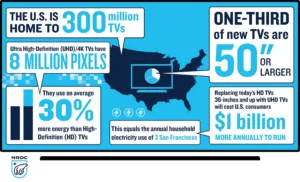The latest ultra high-definition (UHD) televisions use an average of 30 percent more energy than their high-definition (HD) predecessors, which could add $1 billion to U.S. viewers’ annual utility bills if energy-saving improvements are not expanded to all models, according to a groundbreaking report today from the Natural Resources Defense Council (NRDC).
“Not only do today’s large UHD televisions consume almost one-third more energy, on average, than the high-definition (HD) TVs they’ll replace, there is a huge range in the efficiency of the UHD models on the market,” said senior scientist Noah Horowitz, director of NRDC’s Center for Energy Efficiency.
“We found an almost three-fold difference in energy consumption between the best and worst UHD TVs, with some models using little or no more energy than their HD predecessors, proving the technology already exists to cut needless energy waste in these large televisions,” Horowitz said.
NRDC’s report, “The Big Picture: Ultra High-Definition Televisions Could Add $1 Billion to Viewers’ Annual Electric Bills,” is the first to analyze the energy use of televisions known as ultra-high definition due to their superior picture quality with 8 million or more pixels. These televisions are sometimes referred to as 4K TVS because the images are about 4,000 pixels wide, and have four times as many pixels as an HD television.
NRDC and its partner, Ecos Research, analyzed public databases of UHD television energy use and market share sales data, and also performed power use measurements on 21 televisions representing a cross-section of 2014 and 2015 models. The testing focused on 55-inch TVs because they are the most prevalent size and represent the best value among UHD televisions on the market today.
NRDC’s key findings:
- There are 300 million installed TVs in America. Without additional efficiency improvements, a national switch from HD televisions with 36-inch and larger screens to UHD TVs, alone, would cause America’s annual electricity use to jump by 8 billion kilowatt hours – three times the amount consumed by all the homes in San Francisco in a year and as much electricity as is generated by 2.5 large (500-megawatt) power plants.
- The switch to UHD also would create an additional 5 million metric tons of carbon pollution from generating the extra electricity required.
- One-third of all new televisions sold today have screens 50 inches or greater. TV power use often increases with screen size and NRDC’s analysis showed that some of the really large, least efficient models used as much annual energy as a new refrigerator.
- The new High Dynamic Range, or HDR, feature that provides brighter colors and deeper shadows could significantly increase national TV energy consumption. Our testing showed the HDR version of a movie used 47 percent more power than the same title in 4K format. More attention is needed to understand HDR energy use and reduce it.
The report is not all bad news for UHD TV buyers as it lists steps that can be taken to reduce the power drain of UHD televisions:
- Enabling Automatic Brightness Control, which adjusts screen brightness in response to changes in room light levels, caused televisions to use 50 percent less power, on average. However, energy savings varied by model and ranged from 17 percent to 93 percent.
- Consumers can cut several hundred dollars off the lifetime energy costs of a new UHD TV by a) buying models with the ENERGY STAR® label, b) ensuring Automatic Brightness Control is enabled, and c) avoiding the quick start feature on Internet-connected televisions that results in significant amounts of wasted standby power.
“The national energy and environmental consequences of the transition to UHD TV will be profound unless the TV manufacturing industry devotes sufficient time and resources to improve the efficiency of the TVs brought to market,” Horowitz said. “The good news is that there are steps consumers, manufacturers, and policymakers can take to make sure our newest-generation televisions are not needlessly wasting energy.”
NRDC’s analysis was not designed to rank individual TV brands, but to gauge whether there might be differences in the energy use of similar-sized UHD TVs and to gain insight into the major elements factoring into UHD energy consumption, such as the quick start and automatic brightness features on some models.

